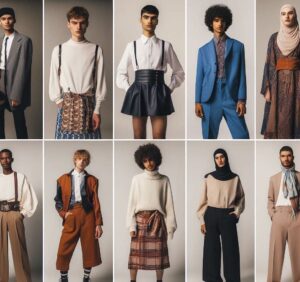Historical Context

Historically, the gender roles and expectations within the fashion industry have remained profoundly confined, molded by societal norms and the enduring desire to maintain a demarcation between male and female presentations. From corsets constricting the female form in the Victorian era to stiff collars and tailored suits exemplifying the masculine ideal, fashion served as a potent tool to manifest these gender norms.
For women, clothing traditionally didn’t just emphasize beauty, elegance, and fragility; it was a symbolic representation of the societal expectation of feminine passivity and decorum. Feminine fashion has long been employed to embody notions of modesty, delicacy, and docility, enhancing the accepted behaviors of the ‘fairer sex’. Through an array of styles – bustles, hobble skirts, and oversized hats – women were, quite literally, shaped according to societal dictates, reflecting a clear portrayal of gender bias and stereotypes.
By contrast, men’s fashion in history was often designed to symbolize strength, authority, and functionality, mirroring patriarchal values of masculinity. Men were associated with power and dominance, and their clothing was a sartorial manifestation of this hierarchy. The utilitarian designs, earthy color palettes, and overall structural integrity of men’s garments have traditionally alluded to their expected roles as providers, protectors, and leaders. The pointed charade of flamboyant neckties, polished shoes, and tailored suits served to foster an image of success and influence.
These recurring themes were not limited to any one region or culture. Instead, these gender norms have presented through different lenses across various cultural backgrounds and time periods. From the kimono’s sexual implications in Japan to the power politics behind the Italian Renaissance’s lavish accessories, fashion has always been employed to emphasize and enforce gender roles.
Fashion, especially in historic terms, has been an illustrative medium of broader societal structures, demonstrating the ways in which patriarchal values and gender stereotypes have been maintained and propagated over time.
The Manifestation of Gender Stereotypes in Today’s Fashion Industry
In today’s fashion industry, the manifestation of age-old gender stereotypes remains prevalent and influences many aspects of the field, from design to marketing. Despite the ongoing conversations around gender equality and fluidity, the industry seems laggard in truly embracing these concepts. We continue to perceive the gender binary in clothing styles, marketing strategies, and even brand messaging.
In terms of clothing styles, women’s clothes are often adorned with traditionally ‘feminine’ elements like frills, lace, pastels, and floral prints or they are designed to accentuate certain body parts, such as the waist, the bust line, or the legs. The idea is to highlight femininity, an outdated concept derived from traditional gender roles, implying that women should be graceful, gentle, and nurturing. Words such as “soft,” “delicate,” and “pretty” are still common in descriptions of women’s clothing, reflecting societal expectations embedded within the fashion industry.
Men’s clothing tends to emphasize aspects associated with traditional masculinity. Designs often feature broad shoulders, sharp lines, and sleek silhouettes that suggest power, strength, and athleticism. The color palette historically leans towards more neutral or earthy tones, reflecting stoic, pragmatic, and unemotional stereotypes associated with masculinity. Phrases like “rugged,” “robust,” or “tough” are often used to describe men’s fashion, further defining fixed gender roles within the industry.
These stereotypes significantly circumscribe designers’ creativity, pushing them to produce collections that adhere to these established gender norms. This imposes limitations, hindering them from exploring the full potential of their creative license. It strengthens the invisible barrier between “men’s wear” and “women’s wear,” serving to limit understanding and perpetuate gender constructs.
Gender stereotypes extend beyond clothing to marketing strategies: advertisements often portray an egregious reinforcement of these stereotypes. Men are regularly depicted as dominant, assertive, or controlling, while women are portrayed as submissive, passive, or needing protection. These traditional norms are continually reinforced through campaigns, fashion shows, and brand images — where the men exude power and women often appear as pretty props.
Analysis of Effects

The stereotypes found within the fashion industry hold far-reaching implications, penetrating borders of creativity and propagating restrictive societal expectations of gender. These stereotypes not only serve as significant obstacles to creative freedom but also continue to perpetuate damaging societal norms that dictate how individuals should act, dress, or exist based on their assigned gender.
Consumers are progressively molded to associate specific colors, fabrics, or designs with a particular gender, thus reinforcing the mindset that certain styles or colors are inherently ‘masculine’ or ‘feminine.’ Blue for boys and pink for girls is a classic example of this gendered color stereotype, which remains prevalent in today’s society. This subconscious indoctrination begins from a very young age and fundamentally impacts identity formation, societal expectations, and professional aspirations. These associations can perpetuate harmful gender norms, resulting in the overall stagnation of societal progress in achieving gender equality.
These stereotypes contribute to body image issues, given the industry’s heavy reliance on models who fit into a narrow and gender-specific definition of beauty. Female models are typically tall, slim, and are expected to maintain an air of traditional femininity, often accentuating stereotypes of passive, delicate femininity. On the other hand, male models are typically muscular and tall, emphasizing a strong, dominant masculinity. This exceedingly selective representation of body types propagates unrealistic beauty standards and makes consumers feel inadequate or even ashamed if they do not conform to these ideals.
The dominance of gender stereotypes in the fashion industry not only hinders the expansion of creative boundaries but also perpetuates a culture that discourages individuality and self-expression. Pigeonholing fashion styles based on gender restricts people from exploring styles beyond their assigned gender and curbs individual freedom.
Emerging trends, initiatives, and a gradual transformation wave begins to blur gender distinctions in fashion. Gender-neutral clothing lines, more diverse representation of models, and inclusive marketing strategies are challenging and reshaping static gender roles. Recognized fashion weeks are also showcasing more gender-neutral collections, indicating a slow but significant move toward fundamentally changing gender representations.
